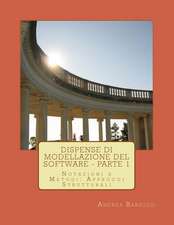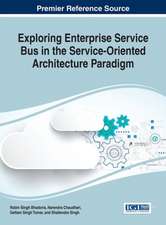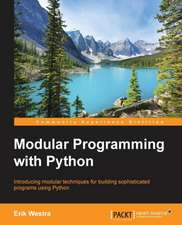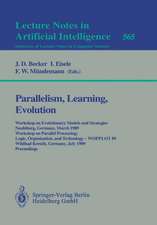Guide to Software Development: Designing and Managing the Life Cycle
Autor Arthur M. Langeren Limba Engleză Paperback – 27 iun 2018
| Toate formatele și edițiile | Preț | Express |
|---|---|---|
| Paperback (2) | 420.95 lei 6-8 săpt. | |
| SPRINGER LONDON – 27 iun 2018 | 420.95 lei 6-8 săpt. | |
| SPRINGER LONDON – 22 feb 2014 | 422.66 lei 38-45 zile | |
| Hardback (1) | 596.83 lei 6-8 săpt. | |
| SPRINGER LONDON – 13 oct 2016 | 596.83 lei 6-8 săpt. |
Preț: 420.95 lei
Preț vechi: 526.18 lei
-20% Nou
Puncte Express: 631
Preț estimativ în valută:
80.61€ • 83.06$ • 67.64£
80.61€ • 83.06$ • 67.64£
Carte tipărită la comandă
Livrare economică 21 februarie-07 martie
Preluare comenzi: 021 569.72.76
Specificații
ISBN-13: 9781447173946
ISBN-10: 1447173945
Ilustrații: XVII, 402 p. 117 illus., 24 illus. in color.
Dimensiuni: 155 x 235 mm
Greutate: 0.59 kg
Ediția:Softcover reprint of the original 2nd ed. 2016
Editura: SPRINGER LONDON
Colecția Springer
Locul publicării:London, United Kingdom
ISBN-10: 1447173945
Ilustrații: XVII, 402 p. 117 illus., 24 illus. in color.
Dimensiuni: 155 x 235 mm
Greutate: 0.59 kg
Ediția:Softcover reprint of the original 2nd ed. 2016
Editura: SPRINGER LONDON
Colecția Springer
Locul publicării:London, United Kingdom
Cuprins
Introduction.- Part I: Determining Needs.- Assessing Business Requirements.- Build vs. Buy Issues.- Establishing Requirements (RFI, RFP).- Searching for Solutions.- Controlling Costs and Realistic Budgeting.- Analysis Methods and Tools.- Part II: Development Architecture.- Creating Requirement Documents using Analysis Tools.- The Data.- Legacy Systems and Data Conversion.- Business Process Reengineering.- Digital Transformation and Consumer Requirements.- Data Analytics and Data Warehouses.- Documentation & Acceptance Testing.- Part III: How to Implement.- Project Management.- Virtual Teams and Outsourcing.- Cyber Security, ISO 9000 and the Software Development Life Cycle.- Vendor Contract Considerations.- Going Live and Conclusions.
Recenzii
“This well-written book will serve as an apt resource for the software development community, especially those working in legacy modernization and digital transformation projects. Many relevant software development topics are discussed in detail and practical tools in the form of templates and checklists are provided.” (Computing Reviews, June, 2017)
Notă biografică
Dr. Arthur M. Langer is the Director of the Center for Technology Management at Columbia University, New York, NY, USA. Dr. Langer is also the Vice Chair of Faculty and the Executive Director of the Division of Innovation and Design at the School of Professional Studies. He serves on the faculty of the Graduate School of Education in the Department of Organizational Leadership. Dr. Langer is also Chairman and Founder of Workforce Opportunity Services (WOS), a non-profit NGO dedicated to assisting socially excluded youth and veterans in education and professional careers. His other publications include the Springer title Analysis and Design of Information Systems.
Textul de pe ultima copertă
This clearly-written book presents a guide to navigating the complicated issues of quality and process improvement in enterprise software implementation, and the effect these have on the software development life cycle (SDLC). Offering an integrated approach that includes important management and decision practices, the text explains how to create successful automated solutions that fit user and customer needs, by mixing different SDLC methodologies. With an emphasis on the realities of practice, the book offers essential advice on defining business requirements, and managing change.
This revised and expanded second edition includes new content on such areas as cybersecurity, big data, and digital transformation. Also highlighted is the importance of interfacing directly with the consumers of the business in the modern age of “digital consumerization.”
Topics and features:
This revised and expanded second edition includes new content on such areas as cybersecurity, big data, and digital transformation. Also highlighted is the importance of interfacing directly with the consumers of the business in the modern age of “digital consumerization.”
Topics and features:
- Presents concrete examples, effective case studies, and chapter-ending problems and exercises
- Concentrates on the skills and insights needed to distinguish successful software implementations and identify sources of failure
- Discusses both management and technical issues, taking into consideration the political and cultural realities in organizations
- Suggests many alternatives for how to manage and model a system using sophisticated analysis tools and advanced management practices
- Describes how and when professionals can best apply these tools and practices, and what benefits can be derived from their application
- Addresses such topics as build vs. buy, searching for vendor solutions, and vendor contract considerations
Caracteristici
Explains how to create successful automated solutions that fit user and customer needs, by mixing different SDLC methodologies Guides readers through the theory, and application in real practice, covering management issues as well as technical considerations Includes chapter-ending problems and exercises, and concrete examples and effective case studies, as well as useful Appendices, a Glossary, and suggestions for further reading Revised and expanded second edition includes new content on such areas as cybersecurity, big data, and digital transformation




























